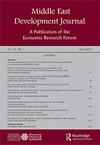Learning by exporting or self-selection into exporting?
IF 0.9
Q4 DEVELOPMENT STUDIES
引用次数: 4
Abstract
ABSTRACT This paper explores the export-productivity relationship using firm-level data from Egypt over the 2003–2008 period. Previous studies using data from developed countries suggest that self-selection is the main driver of the exporter premium. Using a propensity-score matching difference-in-difference approach, we find that both labor productivity and total factor productivity are significantly higher for exporters than for non-exporters. On average, labor productivity and total factor productivity are, respectively, 43% and 61% higher for exporting firms than for domestically-oriented firms. Accounting for the level of development of destination countries, we find that this export premium is due to a learning-by-exporting process rather than just a self-selection of more productive firms into exporting. In contrast to exporters to OECD countries, exporters to Non-OECD countries self-select into export markets, signaling the importance of the technical assistance from OECD buyers.通过输出学习还是自我选择输出?
本文利用2003-2008年期间埃及企业层面的数据探讨了出口-生产率关系。先前使用发达国家数据的研究表明,自我选择是出口商溢价的主要驱动因素。使用倾向得分匹配差异中的差异方法,我们发现出口商的劳动生产率和全要素生产率都明显高于非出口商。平均而言,出口企业的劳动生产率和全要素生产率分别比内向型企业高43%和61%。考虑到目的国的发展水平,我们发现这种出口溢价是由于出口学习过程,而不仅仅是生产率更高的企业自我选择出口。与向经合发组织国家的出口商相比,向非经合发组织国家的出口商自行选择进入出口市场,这表明经合发组织买家提供技术援助的重要性。
本文章由计算机程序翻译,如有差异,请以英文原文为准。
求助全文
约1分钟内获得全文
求助全文

 求助内容:
求助内容: 应助结果提醒方式:
应助结果提醒方式:


